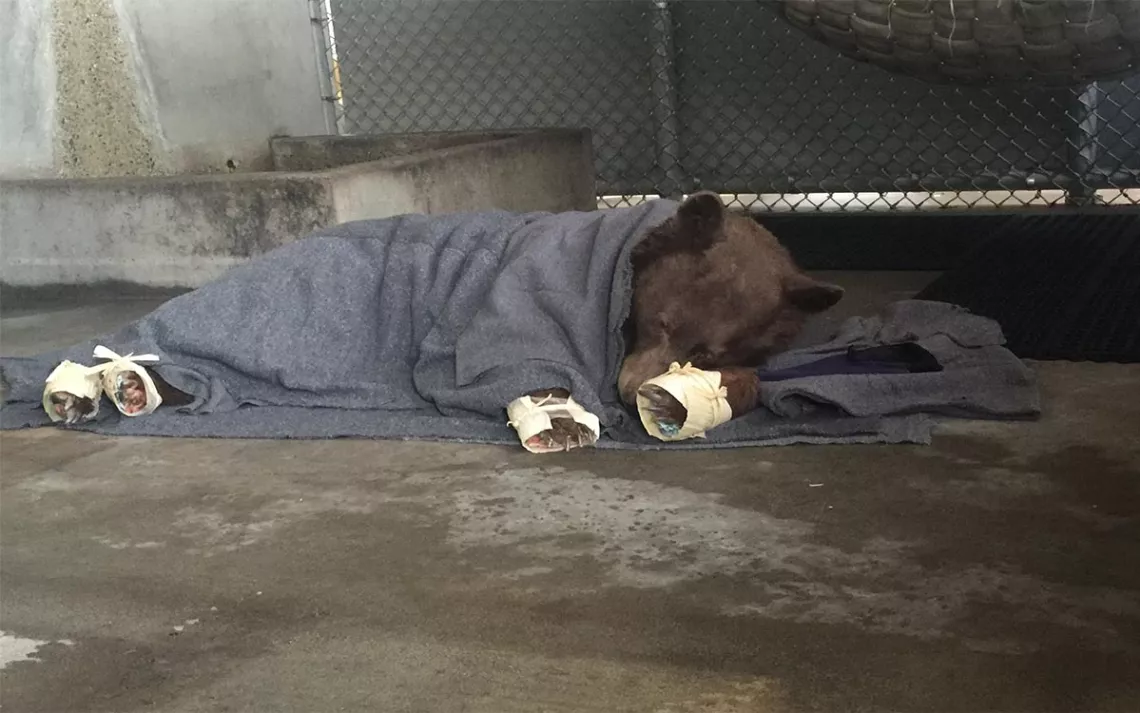Tilapia-Skin “Shoes” Help Bears Recover From Thomas Fire Burns
One problem: The bears want to eat them

Photo courtesy of the California Department of Fish and Wildlife
Tilapia, a farmed fish commonly found in the freezer aisle of your local grocery store, has a new use—as a treatment for black bears burned in Southern California's Thomas Fire.
On December 9, 2017, two badly injured bears were captured by California Department of Fish and Wildlife personnel and brought to the agency’s Wildlife Investigations Lab in Rancho Cordova. Both had severely burned paws; one was unable to stand.
“The outer layer of skin was badly burned on all the paw pads on each bear,” said CDFW senior wildlife veterinarian Deana Clifford. Otherwise, they were good candidates for treatment: “The bears had not sustained serious burns to other parts of their bodies and were in excellent condition, suggesting they were healthy at the time of the fire.”
Due to the time-sensitive nature of the treatment—officials didn’t want the wild bears to become acclimated to human interaction—CFWD enlisted the expertise of Jamie Peyton, chief of the Integrative Medicine Service at the University of California, Davis, Veterinary Medical Teaching Hospital, to help with pain management. The urgency to find an effecive treatment became more apparent when the team found that one of the bears was pregnant.
“I needed every tool in my toolbox,” said Peyton.
Peyton, who also serves as associate director for the UC Davis Center for Advancing Pain Relief, began employing those tools, including acupuncture, chiropractic care, transcutaneous electrical nerve stimulation (TENS), pulsed electromagnetic field therapy, and cold laser therapy. She also applied a burn salve containing honey, olive oil, coconut oil, and beeswax.
But she also needed something inexpensive that would prevent the bears from licking or otherwise interacting with the burns, while simultaneously aiding in the healing process. She remembered an article detailing the ways in which burn victims in Brazil were treated with tilapia skins when no skin grafts were available.
Peyton visited a few live-fish markets in Sacramento and Oakland for supplies. The skins were sterilized and sent to Rancho Cordova. (Her students ate the fish.) The idea was to see if the high-collagen fish skin could act as a healing barrier or “biologic bandage.” Outer wrappings made from cornhusks prevented the bears from chewing off the tasty dressing.
The results were surprising. One bear was able to stand almost immediately after the skins were sutured to its paws. While recuperating in the lab, the bears went through several rounds of skins, which lasted for 10 days. The skins were applied to three paws on each bear (one paw was treated without tilapia as a control) in a two-to-three-hour procedure.
“We are encouraged by the results,” Clifford said, “and think not only the tilapia treatment but all the treatments applied could have a role in helping to alleviate pain and accelerate healing in wildlife suffering from burns.” She said that the CDFW/UC Davis team plans to publish detailed results so the information can be available to other facilities that care for wildlife suffering from burns.
On January 17, the bears were released back into Los Padres National Forest with the tilapia skins on. “They act like little leather shoes,” Peyton said, adding that they will eventually dry up and become a good snack.
The bears are now being tracked via satellite collar. A satellite location for one of the bears was recorded on January 24, showing it within a few miles of its release location.
“The CDFW is committed to learning as much as we can from this experience by determining if the bears are surviving post-release and watching to see if they return to habitat burnt in the Thomas Fire,” Clifford said.
For Peyton, this was her first experience as a vet working with bears. “It’s possible to treat wildlife successfully,” she said. “Along with humans and pets, there was a whole population of wildlife that was affected by these fires. They are our responsibility, too.”
 The Magazine of The Sierra Club
The Magazine of The Sierra Club



